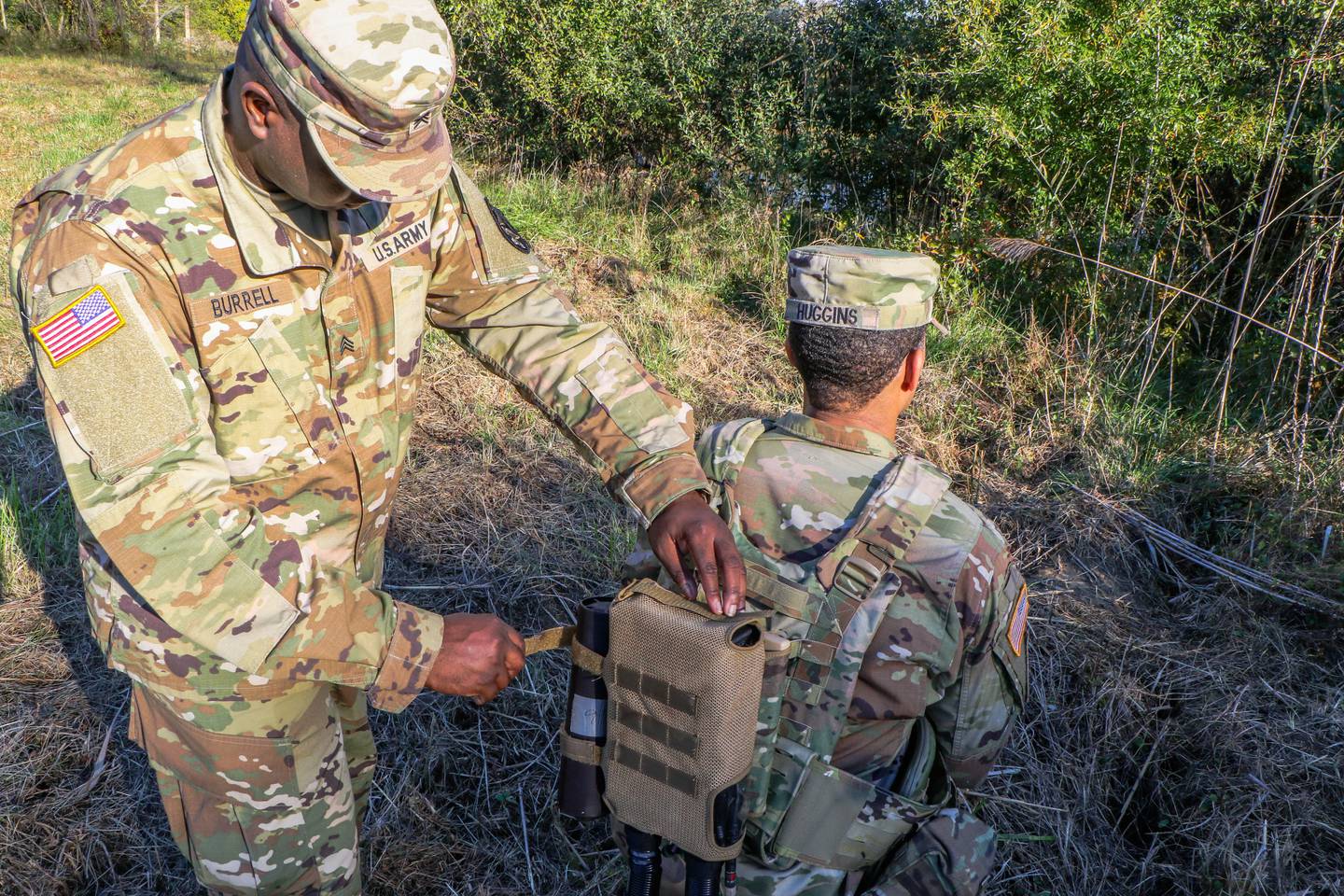WASHINGTON — In generations past, infantry officers’ primary needs were ammunition, an extra pair of dry socks and enough water in the field.
But soldiers today need vast stores of power just to manage daily operations, from the batteries that power the Samsung-based Nett Warrior system that connects soldiers to the electricity that keeps command posts and operations centers running.
Those needs are set to grow within the next decade as the Army moves toward using electric vehicles on the battlefield and weighs a variety of power sources for its facilities and bases. After all, the Army’s new climate strategy imagines a battlefield that depends less on fuel and more on electricity.
It envisions the service fielding hybrid electric tactical vehicles by 2035 and moving to all-electric tactical vehicles by 2050.
To get there, the Army is preparing its first-ever operational energy strategy, which is expected by the end of the year.
The plan focuses on preparing the service to use a range of energy sources, from renewables to fossil fuels to electricity from host nation power grids — changes that could herald dramatic shifts in how the Army spends its multibillion-dollar procurement and research budgets.
In other words, the service wants to map out how it manages and distributes power in operations across the battlefield and is considering a variety of technology that could strengthen that logistics tail — from longer-lasting, lighter batteries to trailer-sized chargers to microgrids.
Army Secretary Christine Wormuth told Defense News that as the service focuses on its ambitious modernization efforts and moves to implement its climate strategy, the logistics and sustainment piece “is often under attended to.”
There is a “strong impetus,” she said, to “put a lot of the resources toward the pointy end of the spear and forget what it takes to feed all of that.”
Energy sources
The operational energy strategy is meant to assess both the individual soldier and energy users ranging from weapons to field kitchens.
To help build the needed infrastructure, the Army is rapidly developing technology that would work toward a widely electrified battlefield.
The service is already fielding generators that provide better fuel efficiency, system reliability and parts interoperability as compared to diesel generators, according to Elise Joseph, who focuses on energy at Army Futures Command.
In its climate strategy, the Army calls for the creation of a more flexible power source by deploying generators with mobile microgrid systems paired with battery storage. The service wants to make this capability usable on the battlefield, Joseph said.

The Army’s C5ISR Center is also working on mobile microgrids, including turning a vehicle into its own microgrid that can then charge soldier batteries in the field. The center is developing “on-soldier power infrastructure” as well as experimenting with wearable solar panels and portable fuel cells. It also entertained the concept of a backpack that harnesses energy from the bouncing created by a moving soldier wearing it. These advances would create new, mobile power sources on the battlefield.
Another area of focus is battery standardization, as the abundance of batteries creates a significant logistics issue, Joseph told Defense News.
“There are so many different kinds of batteries, and so you need individual chargers for each of those, and you’ve got soldiers carrying around all these batteries,” she said. “We are considering that in development and trying to push toward some standard form factors.”
The directorate hopes to make batteries quicker to recharge and longer lasting between charges, she said.
The Army Applications Laboratory, which falls under the purview of Army Futures Command, is wrapping up an eight-week effort with industry focused on sustainment technologies for expeditionary power, according to Lt. Col. Brian Cook, the lab’s network lead.
The program specifically examined how to get power to a soldier in an austere environment from four different angles: power management, distribution, generation and sustainment.
More than 70 companies applied, and the Army selected four to participate: Epirus, Resonant Link, Spark Thermionics and Xerion Advanced Battery. Those four worked with Army officials and soldiers to discuss the service’s needs for the future battlefield and to develop ways to solve those power challenges.
A similar program last year produced a tactical battlefield recharging concept from a Colorado-based company, Cook noted. The recharger was the size of a shipping container, which roughly equates to a small room that can fit on the back of a semitrailer truck.
“We’re trying to get that down into smaller form factors so that you can attach it to different ground-based platforms,” he said.
Powering the soldier
The service also wants to ensure soldiers have the power to run key systems. Col. Denny Dresch, the product manager for ground soldier systems at Program Executive Office Soldier, said troops need reliable power to use existing equipment like the Nett Warrior as well as forthcoming systems like the Integrated Visual Augmentation System, considered a next-generation situational awareness tool.
“We’ve seen the demands on the soldier [are] just going to continue in the future,” he told Defense News.

Nett Warrior, for instance, relies on battery power either through the radio battery into which it plugs or an external battery called the conformal wearable battery. The CWB gives a soldier 18-24 hours of power, according to Dresch. That’s much more than the six to eight hours provided on the radio battery.
The batteries are the size of a small notebook and weigh about 2.5 pounds.
“As you look at the battlefield of tomorrow and you look at what’s going on [with] the soldier, there’s going to be more computational power, there’s going to be more devices that we plug into him or her, and all that’s going to require more power,” Dresch said.
His team is considering how to improve lithium ion-based batteries; one option is using silicon anode technology, a move now under evaluation within the Army’s science and technology branch, he said.
The Army has also developed a universal battery charger, mounted and integrated within a vehicle’s power system so CWBs can charge on the go, Dresch said.
He’s also pursuing the Power on the Move program, meant to equip troop compartments in Bradley Infantry Fighting Vehicles or Stryker combat vehicles with charging stations. The capability was evaluated on a Bradley at California’s Camp Roberts in September; the Army plans to try it with a Stryker in August at Joint Base Lewis-McChord in Washington state.
Dresch said the Army is asking industry, when developing systems, to focus on products that use less energy.
“We are going to run into a problem eventually where physics, science and math can only go so far in terms of how good the battery technologies are at this time and place,” he said. “It’s on our industry partners that are bringing those capabilities to our warfighters to also be very conscious of the energy draw that they’re placing on us.”
The role of industry
With the Army’s climate plan now public, the defense and energy sectors are seeking business opportunities.
Oshkosh recently announced it developed a hybrid version of the Joint Light Tactical Vehicle. And companies developing microgrids — like Schneider Electric, which built one that powers Marine Corps Air Station Miramar — are showing interest in the Army’s push to use the technology at installations and in the field.
Plasan North America has been pitching an All-Terrain Electric Mission Module — or ATeMM — which John Cavedo, its president, says is a single platform that solves a variety of power capability and logistics issues.
The capability looks like a trailer, but instead of sucking power from the vehicle towing it, the module provides power, essentially converting the attached vehicle into a hybrid one. The system can also supplement generator power at command posts and act as a mass mobile charging station for conformal wearable batteries.
The Army invited Plasan to demonstrate the ATeMM as a platoon battery recharger at the Army Expeditionary Warrior Experiment at Fort Benning, Georgia, which wrapped up in March.
But without an Army document that addresses the logistics of operational energy and provides clear direction for industry, the path forward for the technology is murky, Cavedo said. The Army hasn’t “conceived of taking all these different capabilities and putting them into one package because of the way that it writes requirements,” he argued.

Some industry executives in recent years have expressed concern the Army is unprepared to depend on electric power without more extensive infrastructure.
Sharon Burke, who served in the Obama administration as assistant secretary of defense for operational energy and is now president of consultancy Ecospherics, said she’s seeing evidence that industry recognizes the Army’s interest in different energy options. At the Association of the U.S. Army’s annual conference last year, she noticed lithium-ion batteries throughout the exhibit floor.
“You wouldn’t have seen that kind of equipment at AUSA if those vendors didn’t think that there was an interest,” Burke said. “You definitely see things that people are prospecting, and they’re just wrong. But in this case, I don’t think they’re wrong.”
The Army is also weighing whether commercial technology provides a path forward. Several years ago, the service’s Combat Capabilities Development Command’s Ground Vehicle Systems Center watched as commercial carmakers began investing in electrification.
The command’s power and energy team set up a series of electrification forums across the United States, asking companies whether they were focused on how to recharge in an austere environment, said Michael Cadieux, the center’s director.
“Industry didn’t raise their hand. They weren’t saying, ‘I’m thinking about it,’ ” he told Defense News in a recent interview. But “roughly over the last nine months, we’ve seen a significant shift.”
Industry is “coming to the table and engaging with us, saying ... they have something that [they] think is a unique product or capability and it starts to address or get at tactical recharging.”

Cadieux said the shift is likely a result of increasing interest in and sales of electric vehicles in the United States. At the same time, more companies are working on battery chemistry and density, he noted, which will affect how vehicles charge.
The Army is already incorporating anti-idle capability, Cadieux said, which saves power on the battlefield and enables vehicles to run systems like communications equipment without burning fuel.
Ground Vehicle Systems Center this month demonstrated its Tactical Vehicle Electrification Kit on a Joint Light Tactical Vehicle, aiming to generate 20% fuel savings with a 50% reduced engine run time. According to a recent statement by the center, the kit allows the vehicle to run vital systems without the engine.
But battery energy density and tactical recharging remain challenging when it comes to moving toward electric vehicles for the service.
“When you get to certain hybrid configurations, you don’t have to solve that gap,” Cadieux said. “Or it’s not as big of a gap.”
At Project Convergence this fall, the Army’s annual exercise for experimenting with emerging and future capabilities, hybrid power prototypes for ground vehicles will likely attend. Also likely to make an appearance are hybrid generators that can go into quiet mode as well as different battery solutions.
Burke acknowledged there is already equipment in the field that uses electric power, but “it does require a larger concept of operations” to broadly adopt this kind of technology.
“When you are talking about the vision that’s in the Army climate strategy, that’s a very different kind of battlefield in 20 years or 30 years now,” she said. “They are not there yet.”
Jen Judson is an award-winning journalist covering land warfare for Defense News. She has also worked for Politico and Inside Defense. She holds a Master of Science degree in journalism from Boston University and a Bachelor of Arts degree from Kenyon College.





